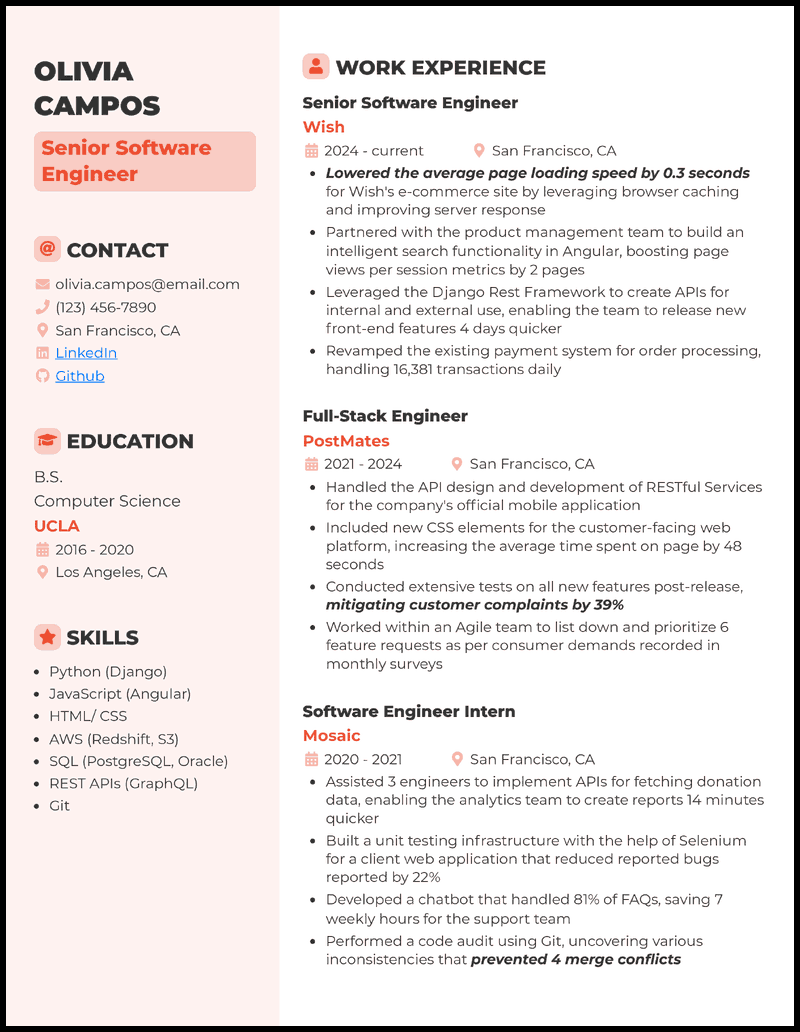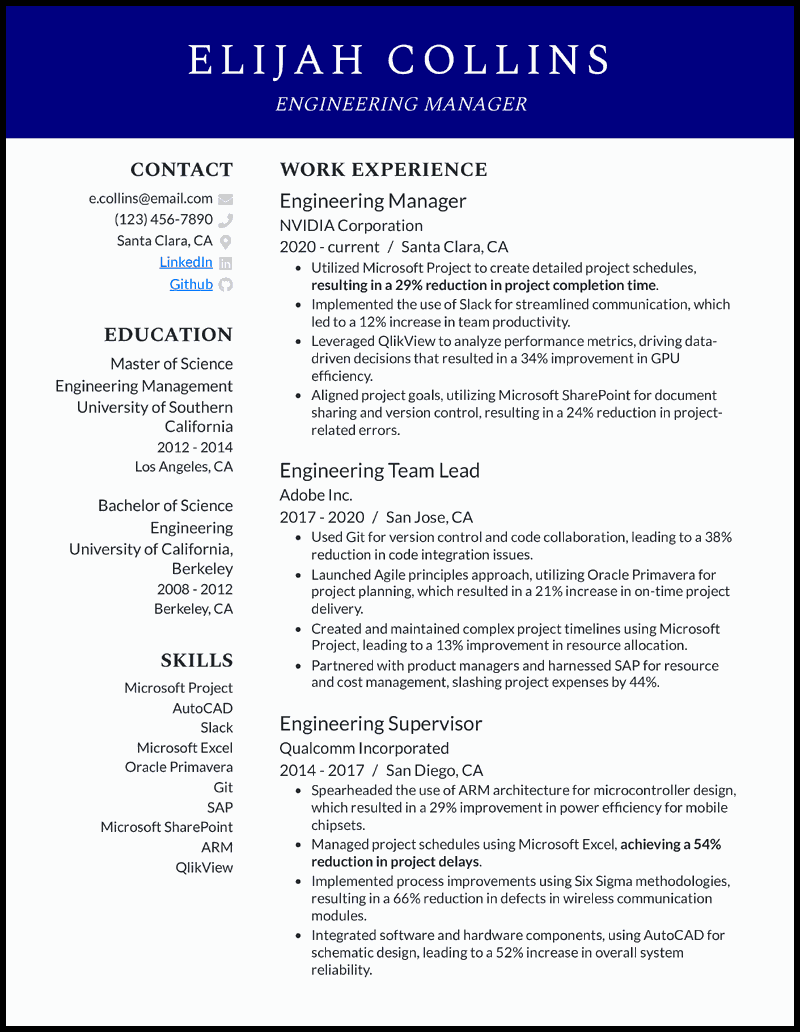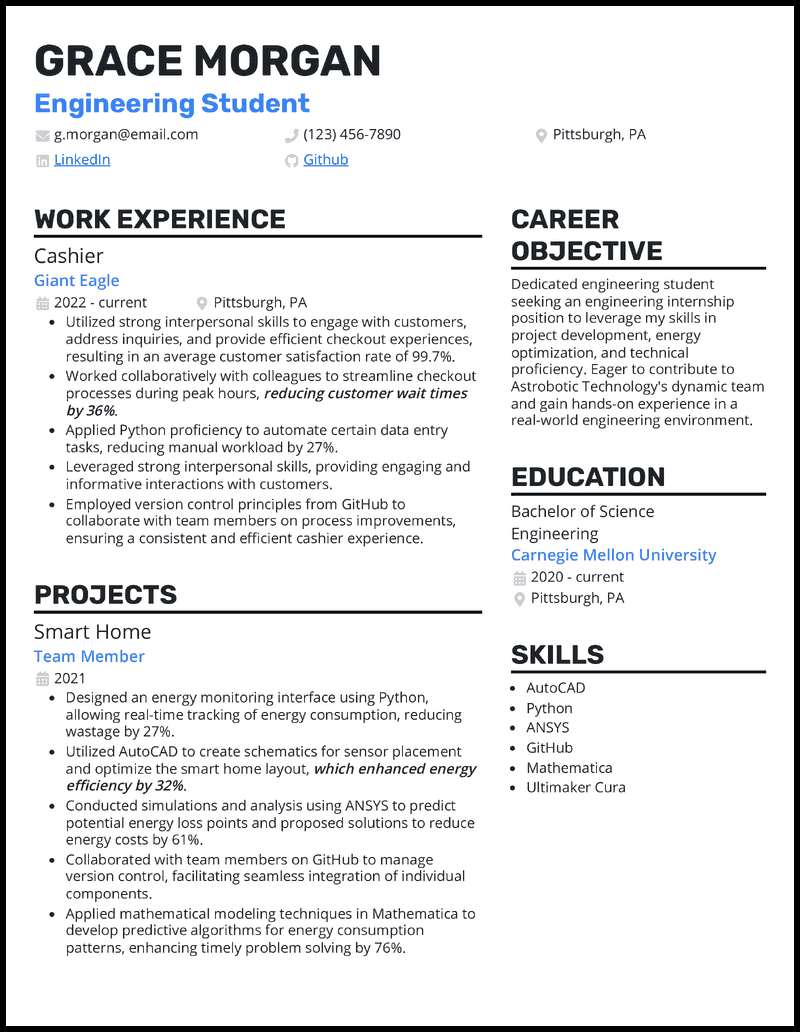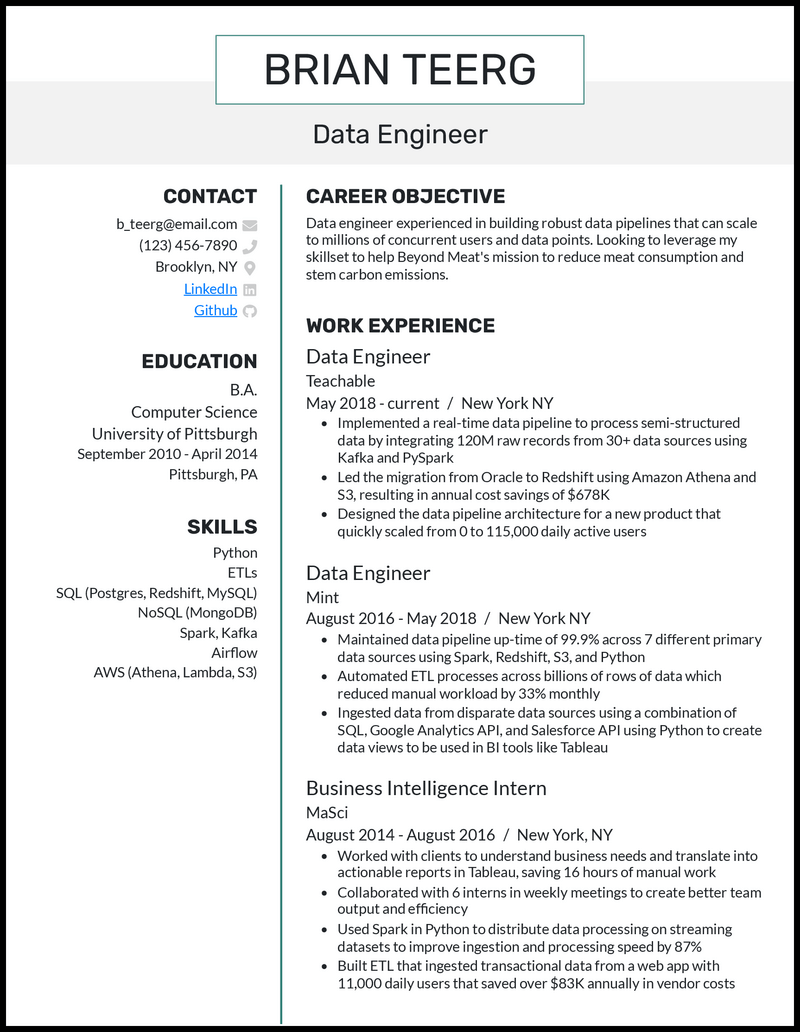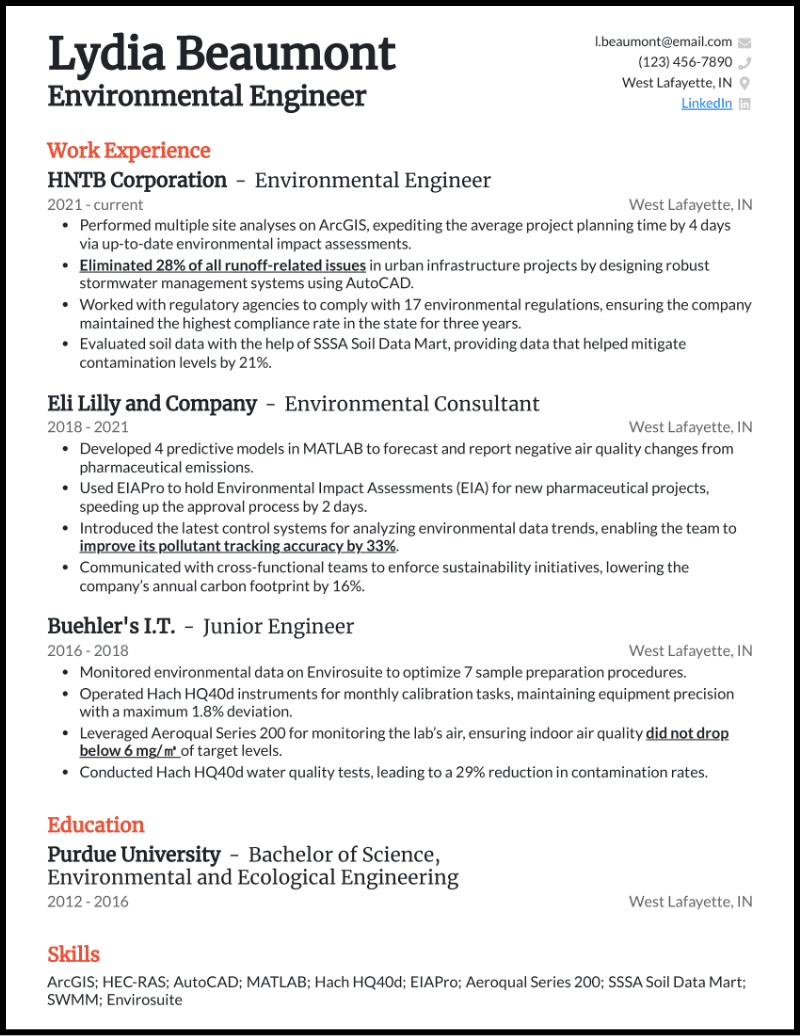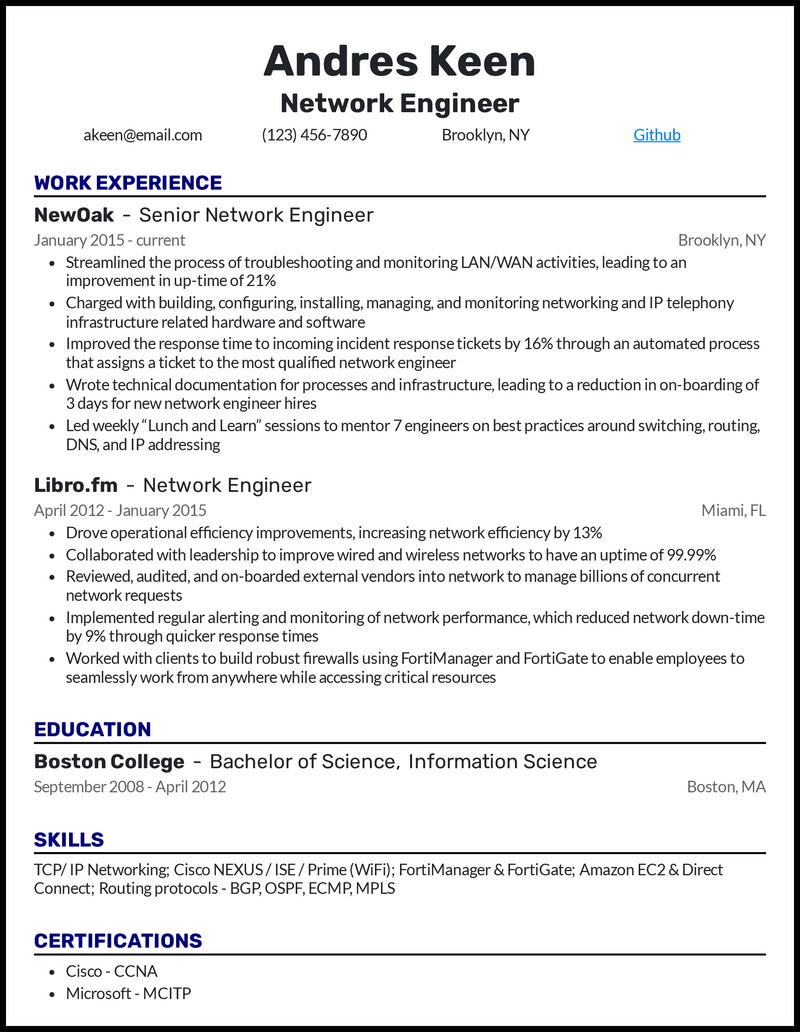
Engineering





Best for senior and mid-level candidates
Resume Builder
Like this template? Customize this resume and make it your own with the help of our Al-powered suggestions, accent colors, and modern fonts.
Regardless of what type of engineer you are, you’re meticulously logical with a flair for numbers.
You shouldn’t also have to be an expert cover letter writer or resume maker to showcase your abilities and secure your next (or first) engineering job.
Getting started is the hardest part of building an engineering CV. Our 25 engineering CV examples are helping engineers secure interviews in 2026, so they’re an excellent starting point for inspiration and valuable resume tips.
Why this CV works
- A resume objective is optional. Only include an objective if you’ll take the time to customize it to each software engineering role you apply for.
- Tailor it to each job by mentioning relevant keywords in the job description (which genuinely apply to you!) and list the target company by name.
- Your engineering resume should mention the technologies in which you have experience. You can list these tools, programming languages, or technologies in a dedicated resume skills section.
- We recommend limiting the web developer skills section to no more than 10, as a lengthy list can be a warning sign to employers.
Why this CV works
- Clearly outline the tech stack you’ve worked with in previous roles on your software engineer CV. It’s also a good idea to mention which programming languages and frameworks you’re most comfortable using.
- As a general rule, only include a programming language on your CV if you can demonstrate coding solutions on a whiteboard in that language.
- Where possible, quantify the impact of your previous projects. These can be rough estimates linked to any metric (revenue, reduced downtime, efficiency improvements, etc.).
- If you’re worried you might miss something and want to see if your CV contains enough metrics, compare it against our AI-powered resume checker for quick fixes.
- Need a bit more detail? We’ve got you covered with our software engineer CV examples for 2026.
View more software engineer resumes >
Why this CV works
- Your engineering manager CV can highlight your role in streamlining communication through Slack and SharePoint, as well as process optimisation through Six Sigma. This approach will position you as a results-oriented professional capable of delivering exceptional outcomes in complex engineering environments.
- And those are qualities that hiring managers will quickly notice and appreciate.
View more engineering manager resumes >
Why this CV works
- Your engineering student CV isn’t expected to have a lot of experience in the real world of your profession. That should not dampen your hopes of securing the job. Your projects can bridge that gap and put you in a position to get noticed.
- Also, don’t overlook your proficiency in tools like AutoCAD, Python, ANSYS, and so on because they demonstrate your ability to utilise smart tools to enhance performance.
View more engineering student resumes >
Why this CV works
- You know, sending out the same old one-size-fits-all CV for every engineering job opening is really easy, isn’t it? But what you didn’t realise is that it’s wasting your chance to impress the hiring manager. Why not play it safe by tailoring your masterpiece for the specific role you’re interested in?
- Customising your industrial engineering CV involves incorporating relevant details from the job advert, or in simpler terms, strategically placing the right keywords throughout your document and ensuring that your bullet points address the requirements outlined in the job description. For instance, if they require someone skilled in AutoCAD, why not describe how you’ve used it to optimise layout design for equipment installations?
Why this CV works
- As a data engineer, quantify the size and scale of the data systems and pipelines you’ve managed. For example, if you constructed a data pipeline for streaming data for a consumer app with 500,000 concurrent users, make sure to specify that.
- If possible, your data engineer CV should also demonstrate the impact your work has had on the business. These can be estimates.
- Did you help increase revenue, improve site speed, or reduce the time spent on manual reporting?
- By emphasising your impact on the business, you make it clear to the hiring manager that you’re focused on what truly matters to the company.
- Need a bit more help? Check out several more data engineer CV examples for 2026.
View more data engineer resumes >
Why this CV works
- Breaking into the aerospace industry isn’t easy, so make sure you tell the full story of how you’ve risen to your current position.
- Don’t hesitate to include roles such as Systems Engineer and Design Engineer in your aerospace engineering CV. These demonstrate that you have experience beyond just developing aerodynamic models. You never know if skills like CFD simulations and automating data integration are the additional abilities an employer is seeking.
Why this CV works
- If you’ve had a long career in the biomedical field so far, you deserve a CV that does it justice without squeezing bullet points into tiny text.
- That’s exactly what the Standout resume template is here for. See how Opal uses it to enhance their biomedical engineering CV in a tidy reverse-chronological format. Put yourself in their position to write about your early lab days to speed up sample processing.
Why this CV works
- We understand that you want to demonstrate you fit the bill and all. However, don’t fall into the trap of filling the work history of your engineering technician CV with every job you’ve ever had; that approach will fall flat.
- Grab a piece of paper and note down all the jobs you’ve handled in the past decade. Then, select three roles relevant to the available position—consider an engineering placement, the time you excelled as an engineering assistant, and your most recent role as an engineering technician. Next? Organise these positions in reverse chronological order, enhancing each entry with quantified achievements.
Why this CV works
- Being a senior isn’t about just turning up, getting updates, and leaving—it’s about taking responsibility for large-scale projects and driving key business impacts, so skip the minor details and include your best achievements.
- We’re talking about things like reducing project completion times, minimising deployment errors, keeping production downtime to a minimum, and staying within budget. Ensure that every bullet point of your senior engineer manager CV highlights how your leadership brought about a positive change.
Why this CV works
- As a newcomer, your career objective will help you condense your best qualities into one place and convince employers that you’re ready to design innovative solutions.
- If you don’t have any past-related projects, then start off by talking about your skills in important tools like AutoCAD and programming languages like MATLAB. Also, remember to tailor the objective of your university engineering CV to the company you’re applying to.
Why this CV works
- Turning your love for the environment into a full-time career? Good on you! Just make sure that your environmental engineering CV reflects that passion with specific skills.
- Employers will naturally expect you to be a team player, so focus on including key software like SSSA Soil Data Mart, Envirosuite, and HEC-RAS. Make them a testament to your ability to handle tasks such as site analysis and soil evaluation.
Why this CV works
- Ideally, you want your VP of engineering CV to radiate authority and speak volumes about your passion for innovation. This is one of those cases where including more than three work experiences will work in your favour.
- But what will really help you secure the deal is using quantified bullet points. Phrasing such as “Led Jira integration… reducing sprint cycle times by 2 days” demonstrates that you’re capable of managing supervisors and streamlining agile processes.
Why this CV works
- You can be sure that any hiring manager is on the lookout for exceptional candidates. To secure a place on that dream team, you need to enhance the work history section of your structural engineering CV with quantified outcomes.
- Phrases backed by numbers, such as “Developed and optimised 3D models with Tekla Structures for a £52 million bridge project, expediting clash detection by 38%”, set you apart from other candidates and highlight your value. With that added touch, you might just leave the competition behind.
Why this CV works
- Normally, for a job at this level, creating a two-page head of engineering CV seems most fitting, but we don’t recommend stretching things out just to fit the mould.
- Think you can showcase your leadership skills in just three outstanding work experiences? Aim for a one-page CV. Include your most recent job at the top and let older roles fill the remaining spaces as you go towards the bottom.
Why this CV works
- We understand—capitalising on creative resume designs might seem like a clever way to add visual interest to your sales pitch. Unfortunately, they could make you appear unprofessional and harm your chances in an interview in the long run. What a shame.
- Opt for that straightforward CV template you’ve come across online. You’re aiming for something that is easy to read and highlights your qualifications, so don’t even consider decorative fonts like Comic Sans; classics like Calibri, Times New Roman, and Georgia will suffice. Your engineering consultant CV will also stand out with concise bullet points (each taking one or two lines) and some breathing space in the form of white space.
Why this CV works
- If you’ve worked hard to earn certifications (CCNA, MCITP, etc.), list them in a dedicated “Certifications” section on your network engineer CV. Doing so makes it clear to the hiring manager that you have the required technical skillset.
- Have you mentored or led other network engineers either on a project or full-time basis? Include that on your CV, sharing the number of people you mentored and how.
- This type of leadership experience can distinguish you from the competition.
- Our network engineer CV examples for 2026 can also help get you where you’re going with some added insight.
View more network engineer resumes >
Why this CV works
- A good way to create a standout petroleum engineering CV is to show that you got a head start in the industry early on.
- Use any project or internship experience from your university days, even if you completed it within the last year. Don’t worry about having the most impressive metrics. Craft bullet points that emphasise how you learned important skills like managing fracturing fluid and optimising drilling strategies. Sometimes, proving you’ve learned the ropes is all you need.
Why this CV works
- Keen to secure your first engineering job while at university? Highlight past projects in your Mizzou engineering CV.
- Even a straightforward project like being a model presenter can work wonders if you handle it wisely. Leave the presenting part for later and ask questions such as: How accurate was your model? Did it include important mechanics-related quantities like stress points? Address these in your bullet points and you’ll be quantifying key impacts before you know it.
Why this CV works
- Yes, you only have a few seconds to impress the recruiter, which is why we suggest highlighting a few outstanding achievements on your financial engineering CV.
- Take Yara, for example. By emboldening phrases like “…assess credit risk for 53 clients” and “…managing £513M in assets”, she captures the recruiter’s attention immediately while indicating her potential impact if she joins the team.
Why this CV works
- For a PhD engineering CV that transitions you into a new career phase, make the most of the appropriate language to present yourself as the perfect candidate. Our advice is to avoid using jargon in your pitch unless you want to annoy the hiring manager and ruin your chances.
- We fully support using straightforward language to describe your relevant work experiences and other qualifications. Trust us, the last thing the hiring manager will do is reach for a dictionary to understand the seemingly fancy words in your CV. For instance, “Designed dynamic simulation models” works well instead of “Conceived and executed sophisticated computational fluid dynamics models to emulate advanced aerodynamic phenomena.”
Why this CV works
- Aren’t picture CV templates everywhere? But how could adding a photo of yourself to your materials engineering CV be a bad idea? Well, many things could go wrong with what many candidates might believe is enhancing their masterpieces.
- You see, adding a picture to your CV doesn’t just thrust you into the realm of employee discrimination based on appearance, gender, or race. The electronic gatekeepers that are ATS bots don’t handle visuals well. And the potential outcome? Recruiters might never even see your application.
Why this CV works
- When your limited experience is urging you to send out your junior engineering CV as soon as you see that job advert, remember that “More haste, less speed.” Our point? Don’t even think about hitting that “Submit” button before you’ve given your masterpiece a thorough once-over for any grammar and spelling mistakes that might be lurking, ready to jeopardise your work.
- Yes, grammatical mistakes like typos can prevent you from securing that job. Why? They indicate to recruiters that you’re inattentive to detail or not genuinely interested in the role. That makes proofreading your application essential. Editing software like Grammarly and a second pair of eyes (from, say, a family member or friend) are excellent options here.
Why this CV works
- No one can become a professional geotechnical engineer overnight. That’s why demonstrating healthy career growth can help you create an authentic geotechnical engineer CV.
- You can include your previous positions where you undertook location-specific tasks such as developing geotechnical models and analysing soil samples. Don’t hesitate to mention short-term roles either. They demonstrate your ability to learn quickly and portray a candidate who has continually progressed to reach this stage.
Why this CV works
- As you gain experience in DevOps, your education section should take up less and less space on your resume template.
- Keep your DevOps engineer CV to one page because space is invaluable.
- Instead, make your work history the standout feature on your CV.
- Sprinkle your work experience sections with numbers and metrics that quickly demonstrate your qualifications.
- Use action verbs like “built,” “created,” and “owned” to demonstrate your leadership experience and prove you’ve made a significant impact in your previous roles.
- If you’d like more ideas, we have several additional DevOps engineer CV examples for 2026.
View more DevOps engineer resumes >
How to Format an Engineering CV

How you format your engineering CV can determine whether you get an interview. Your CV needs to be in a logical format that can be quickly reviewed and should include all necessary information. If you leave important details out of your CV, you won’t have the opportunity to prove yourself.
Let’s briefly explore our three top tips for resume formatting for engineers:
- Reverse-chronological, functional, and combination/hybrid formats
- Contact information and header
- ATS & readability

Reverse-chronological, functional, and combination/hybrid formats
Engineering CV Formats
- It sounds more complicated than it is. Reverse chronology means the information listed on your CV begins with the most recent experience. For example, your current job, which you started five years ago, is listed at the top. The job you had before is listed right below it.
- The functional CV format emphasises your skill set over your experience. The functional CV is also known as a skills-based CV because it highlights how your skills and abilities qualify you for a job. For example, you could focus on a skill set you’ve utilised across several jobs. Even if the job was 20 years ago, your experience would still be beneficial today. Using MySQL in your very first job will still be relevant if the position for which you’re applying also requires MySQL.
- The combination/hybrid CV format is exactly what it sounds like. You combine the best parts of a functional CV with a reverse-chronological CV. This is done by including a skills section first, followed by your experience. It immediately shows employers your skill set and experience.
Engineering is certainly a field with ample opportunities for career progression. In 2026, reverse-chronology formatted CVs are ideal for engineers because they highlight your most recent experience first, as well as a growth in responsibilities over time. Additionally, this format allows you to include more details for more recent positions and less information for older roles.

Formatting your engineering CV’s header and contact information
You’ll want your header to stand out professionally. Many of the resume examples we have show your name in large letters at the top of your CV. We recommend the following:
- Use a font size of at least 16 points.
- Use a serif font like Times New Roman, Helvetica, or Bookman Old Style.
- Avoid cursive or curly typefaces.
- Write your name in bold colours like black or dark blue.
- Avoid overly bright colours like purple or orange.
Also, include the title of the position you’re applying for directly under your name. Are you applying to be a DevOps Engineer? A Network Engineer? A Data Engineer? Your future employer should know the position you’re applying for straight away.
Additionally, you’ll want your contact information close to your name. Some CV writers put this information directly under their names, but you can also place this at the top of the sidebar. Include the following information:
- Your phone number
- Your email address
- Your town and county
- Links to professional networking sites such as LinkedIn or GitHub
When all is said and done, the header of your engineering CV might look something like this:
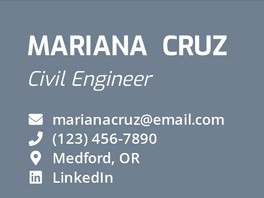

Will your engineering CV make it through ATS?
Most employers use an Applicant Tracking System (ATS) to filter through CVs. If your CV is hard to read, the ATS could remove it from the system before employers even have a chance to look at it. For this reason, you’ll want to take the following steps to ensure your CV is ATS-compatible:
- Don’t use charts or images in your CV.
- Use simple, round bullet points; complex graphics don’t make sense to ATS.
- Include keywords from the job advert in your skill set.
- Save your document in .pdf and .docx formats.
To save you a hassle, we think you’ll love using our AI resume builder, automatically ensuring your CV is ATS-friendly.
How to Write an Engineering CV

Writing your engineering CV may feel daunting. It feels like a lot to take on because a lot depends on it. It can be anxiety-inducing, to say the least. We understand this well, so we’re devoting this section to breaking down how to write your resume.

Do you need an objective or summary for your engineering CV?
The objective of your CV is to secure a job. If you write an objective, you’ll want to clearly outline the type of job you’re seeking. A summary is different. Its purpose is to provide a brief overview of your entire CV.
Weak CV summary example
Skilled DevOps engineer with 10 years of experience in nodes, infrastructure, and server management. Excellent at time management and saving companies money.
This summary is ineffective because the information can be gathered from other sections of the CV. It’s a waste of space that could be used for other purposes. Here are a couple of examples of strong objectives.
Good CV summary examples
Experienced developer with 8 years of experience in full-stack, consumer-facing applications. Looking to transition to B2B applications to enhance interactions between small and medium-sized businesses at a company like OpenEd.
Experienced data engineer with 5 years in B2B applications. Seeking to transition to DevOps engineering to enhance overall company efficiency by improving applications through user interface.
Both of these examples work because the aim is:
- Clearly written; we know what the applicant wants
- Experience is mentioned
- Desire for growth and change is appropriate
- A clear motive is evident; the applicant isn’t struggling

Work experience for an engineer
Your most relevant experience should be listed first. We recommend listing two to four roles that best demonstrate your qualifications for the position to which you’re applying. You don’t need to list more than four roles, nor do you need to include every job you’ve ever had. The employers reviewing your application have limited time and want to quickly see what you have to offer.
Crafting your engineer bullet points
It’s easy to sink or swim when it comes to job description bullet points. Check your resume for the following:
- Use action verbs and active language. This means writing in the present tense and using verbs that demonstrate action. “Being” verbs (are, is, was, were) are not helpful here. “Action” verbs (collected, sampled, organised) convey strength and a strong skill set.
- Avoid using personal pronouns. Saying “I” is unnecessary since the recruiter already knows you’re referring to yourself. Instead, let the action verb propel your actions forward (Example: Collected samples of different websites…).
- Punctuation is optional. Either include punctuation everywhere or leave it out entirely.
Not every bullet point is created (or, rather, written) equally. Here are some poor bullet points:
- Designed the EmptyNest app
- Fixed bugs and reviewed feedback for future app updates
- Updated the app coding once a month
These bullet points are weak because they don’t provide any information. What is the EmptyNest app? Who is it for? What functions does the app perform? What type of bugs did he fix? Why were user reviews important? What kind of coding updates did he make?
While you can’t include every single detail about your work, asking these kinds of questions will set you on the right path. Here are the same bullet points, written effectively:
- Designed an app called “EmptyNest” to help parents adjust to their children moving out of the home
- Updated app to eliminate lengthy loading times for chat features, resulting in a 32% increase in user engagement with the “Chat” feature.
- Analysed user feedback to implement monthly changes to the app, which increased users by 82% over a six-month period
These bullet points are effective because they provide details that help recruiters understand the project, demonstrate achievement and success, and prove ability through numbers. Metrics are extremely important, so let’s delve into that next.
Measure your impact as an engineer
For engineers, quantifying your impact is a crucial part of demonstrating your success. The numbers tell the full story. While this can be daunting, it works in your favour if you successfully implement quantities and qualifications. Try to include metrics in about 60 per cent of your bullet points.
We recommend the following steps to measure your impact:
- Use data to demonstrate how solutions are being developed to rectify issues:
- Identified mechanical issues in wind turbines and devised repair methods to prevent losses exceeding £7 million
- Demonstrate how changes increased profit or saved time:
- Designed robotic arm to assist in gastrointestinal surgical procedures, reducing surgery time by 80%
Quantifying your impact will demonstrate to employers how valuable your work is and why they should consider you for their role.

Top engineering skills to include
Including your skill set is essential for any CV. How you present skills on your resume is important. You want both your hard and soft skills to be evident.
Your soft skills are the ones you can’t easily demonstrate on paper. For example, managing conflict and communicating with others are essential soft skills. Your hard skills include software you’ve mastered and programmes you use. It’s easy to provide evidence of your work.
- Look for keywords from the job advert description. Implement them throughout your CV to pass ATS software.
- Include four to five hard skills relevant to the role.
- Include soft skills *if* they’re highly relevant to the position; you should list fewer of these than your technical skills.
- Limit the skills you share so that your best shines through. Unnecessary information is not needed.
- List your skills according to your level of experience.
There are countless types of engineers, so whether you’re an aerospace engineer, civil engineer, chemical engineer, etc., these skills provide a broad overview of what will serve you well:
- Maths and physics
- Project management
- Analytical thinker
- Interpreting technical drawings
- CAD
- Design
- Data analysis
- Research
For instance, if you’re a civil engineer, the skills section on your engineering CV may look like this:

Additionally, software engineering is a rapidly growing, evolving field, and if this describes you, here are some of the most in-demand skills:
- Python (Django)
- Java (Spring)
- Ruby (Ruby on Rails)
- PHP (Laravel)
- JavaScript (Node, React, Vue, jQuery)
- SQL (MySQL, PostgreSQL, NoSQL)
- HTML5
- CSS
- AWS, GCS, Azure
- Unix
- Git

An engineer’s education and qualifications
If you’re an engineer, you’ll have your bachelor’s degree at a minimum. You may even need a master’s degree, and some jobs even require a doctorate.
Education is crucial for being an engineer. Without it, you wouldn’t be able to carry out many of the tasks required in your role. In a constantly evolving world and workforce, there is significant pressure on engineers to remain at the top of their field. This involves ongoing education and gaining certification in new programmes as they are introduced.
Many regions have strict requirements regarding continuing professional development. For example, a certain number of hours of continuing professional development may be required to maintain certifications and licences. There isn’t a one-size-fits-all requirement. In fact, these requirements can vary by region and by the job.
If you’re a Trainee Engineer, list the following:
- Relevant course projects that will assist in a graduate position
- Work placement experience
- EIT Certification
- Your degree and classification (if it’s at least a 2:1)
If you’ve been in the field for less than 10 years, list the following:
- All the relevant experience that should be included for ATS
- List your most recent jobs in reverse chronological order
- List continuing education and certifications in reverse chronological order
- Certifications should be job relevant, such as for inspection, design, or reliability
- Include your degree
If you’ve been in the field for 10 to 20 years, list the following:
- Detailed bullet points with job description keywords to satisfy ATS systems
- List the jobs that provided you with specific experience for this role
- List continuing education and certifications in reverse chronological order
- Advanced certifications, such as board certified
- List your qualification

When should you add projects, interests, or hobbies to your engineering CV?
Most engineering jobs don’t offer space for your interests or hobbies on your resume. The exception to this is for entry-level positions. If you’re a recent university graduate, you’ll need to list advanced projects from your university experience. Discussing your interests and hobbies through your projects will demonstrate passion for your career field and encourage employers to give you an opportunity.
Listing interests and hobbies can help you secure a job if it’s a close call between you and another candidate. If you’re equally qualified, being a “better fit” for the company could work in your favour. You don’t have to include interests or hobbies, but doing so might benefit you when you’re starting out, especially if you’re looking for a trendy start-up that’s likely to care more about cultural fit.

Tailor your engineering CV to each position
We know it would be easier to create one CV that you send to dozens of different jobs. But this won’t lead to success. In fact, you’re unlikely to secure any interviews using this approach. ATS will filter out your CV for lacking job keywords.
You’ll need to tailor each CV to each job you apply for. Some drafts of your CV will be very similar to each other. Others may look quite different. Adjust your bullet points, skills, and personal statement for each job. While it takes time, your efforts will be worth it!

Edit and proofread your engineering CV
Engineers are perfectionists by nature. Because of this, it’s important to have a flawless CV. This is where editing and proofreading come in. It’s often overlooked because most CV writers just want to be finished. After all, drafting a CV can take hours, but using our free resume maker can save you lots of frustration and time.
We recommend taking the following steps when editing and proofreading your CV:
- Take advantage of our resume checker to ensure your CV is complete and utilising the best techniques.
- Check for mistakes at least twice, preferably three times!
- Have someone else take a look at your CV.
Secure an Interview & Achieve Your Dream Engineering Job

Bear the following in mind:
- Format your engineering CV in reverse chronological order.
- Include accurate, clear contact details.
- Consider whether you need an objective or a summary.
- Use action verbs and quantify your impact.
- Include your top skills that are most relevant to the role.
- List additional info, such as education, qualifications, projects, interests, and hobbies.
- Tailor your CV to the job with keywords from the job advert to pass ATS.
- Edit your CV to catch careless mistakes.
- Use our AI resume maker to start and finish in as little as 12 minutes.
Congratulations on writing your resume. It’s the first and most important step to getting a job. Without a CV, you can’t submit any applications. But with the right CV and your engineering cover letter complementing it, you can secure the perfect job.
Engineering CV FAQs

To write an engineering CV, include the basics such as your personal details, education, skills, and work experience. Use a clean, professional layout with standard fonts and avoid flashy graphics to ensure your CV easily passes through Applicant Tracking Systems (ATS).
As you choose your engineering CV template, you should adhere to the demands of the job description and the position you’re applying for. You want a document that presents your best qualifications and strengths and convinces hiring managers of your suitability. Whatever template you choose, ensure it is easy to read and clearly defines each section with headings. That way, your CV will pass ATS and impress potential employers when they review it.
Your engineering skills are the most crucial part of your CV. They align you with what the job description demands and what the industry expects from professionals. Don’t just list skills; demonstrate how you’ve utilised them to make an impact and drive innovation and efficiency in your previous roles.
Your engineering CV summary must concisely describe your skills, measurable achievements, and previous work experiences. This statement is the focal point that determines your qualifications, making it easier for recruiters to decide if you’re the right candidate. It’s also essential to ensure that your statement matches some of the keywords from the job advert.




